正电子发射计算机断层成像(Positron Emission Tomography/Computer Tomography, PET/CT)检查在疾病的诊疗中扮演越来越重要的角色[1-4],而最常用的显像剂18F-氟代脱氧葡萄糖(18F-Fluorodeoxyglucose, 18F-FDG)由于其广谱性被称为“世纪分子”,其正电子核素18F由回旋加速器产生一定能量的质子轰击18O水获得,回旋加速器的照射条件和轰击参数对获得高品质高产量的18F尤其重要。
蒙特卡罗方法是核物理实验中最常使用到的模拟计算方法,可以模拟核反应的过程,具有真实性高、准确性强等优点,能够预测实验结果并改进实验方法[5-9]。本文在正电子核素18F生产条件分析过程中,将使用蒙特卡罗方法模拟回旋加速器的质子轰击靶室输运过程,多角度多方法来优化正电子核素18F的生产工艺。
1 材料与方法 1.1 回旋加速器与测量仪器本研究在北京肿瘤医院核医学科回旋加速器正电子药物制备场所完成,回旋加速器的型号为日本住友HM-20S,产生20 MeV能量的质子束流。回旋加速器使用自屏蔽装置,打靶位于屏蔽体中心偏左处。回旋加速器位于房间中心靠左侧,电源柜和空气压缩机等附属设备位于墙侧(图 1)。生产的正电子核素活度测量使用美国CAPINTEC公司CRC-25PET型号活度计,最大量程(18F) 37.4 GBq,分辨率0.001 MBq。
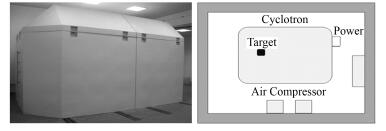
|
图 1 回旋加速器及场地示意图 Figure 1 Sketch map of cyclotron and its field. |
正电子核素18F的生产使用液体靶系统,见图 2。质子束流从回旋加速器真空腔引出后经过真空膜、氦气和靶膜后轰击到高纯18O水,靶材料前后分别通过氦气和循环水进行冷却,真空膜和靶膜材质为Havar膜(Co 42.5%,Cr 20%,Fe 17.46%,Ni 13%,W 2.8%,Mo 2.4%,Mn 1.6%,C 0.2%)。质子初始能量20 MeV,束流强度20-80 μA,轰击时间20-80 min,真空膜厚度10 μm,靶膜厚度50 μm,氦气冷却层厚度6 mm,18O水的腔室厚度3 mm,体积2.1 mL,轰击产生的核反应为18O(p, n)18F,轰击结束后产品传输至活度计中。
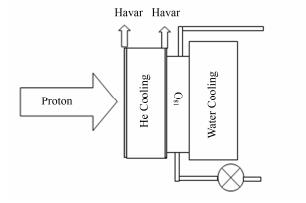
|
图 2 靶照射装置示意图 Figure 2 Sketch of target irradiation device. |
按照靶照射示意图使用蒙特卡罗FLUKA程序建立质子轰击18O水的几何模型,如图 3所示。模拟初始参数为:质子束初始能量20 MeV,能量高斯分布(EFWHM=298.3 keV,θFWHM=11.775 mrad,FWHM为峰值半高宽);束流沿靶室方向照射,径向高斯分布(XFWHM= 6.9 mm,YFWHM=4.1 mm),束流依次通过真空膜(厚度10 μm,密度8.3 g∙cm-3)、氦冷(厚度6 mm)、靶膜(厚度50 μm,密度8.3g∙cm-3)、最后轰击至18O水(厚度3 mm,密度1.429 g∙cm-3)和靶室。
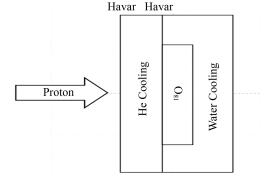
|
图 3 蒙特卡罗质子照射靶室几何模型 Figure 3 Geometry model of proton radiation target chamber using Monte Carlo method. |
质子照射靶材料产生核反应,最重要的两个参数就是束流强度和轰击时间,理论上轰击时间越长束流越大,产生的核素产量也越大,但是由于轰击时间的增加,产生的核素会随着时间进行衰变,达到一定轰击时间核素产量将达到饱和,而且过大的轰击束流和轰击时间会加速机器的损耗,减少使用寿命等,所以寻找最佳的轰击时间和束流强度是核素生产的关键。
统计并分析北京肿瘤医院自2014年1月至2017年1月期间于不同束流强度20-80 μA和轰击时间20-80 min下18F核素产量的变化,使用Origin 9.0(OriginLab公司,美国)软件绘制18F产量随轰击时间和束流强度的变化趋势曲线,并分析优化18F核素生产最佳的生产束流强度和轰击时间。
1.4.2 质子能量由核反应18O(p, n)18F的激发函数曲线获悉[10],核素18F的最佳生产质子能量在5-8 MeV可以获得最高的核素产额,但实际生产过程中质子束流经过真空膜、靶膜和18O水后能量衰减,质子轰击到靶室上的能量将发生改变。
通过蒙特卡罗方法建立的靶照射质子输运模型,模拟不同质子能量5-35 MeV的18F的产量随质子能量的变化情况,并使用Origin软件绘制18F产量随质子能量的关系曲线,并分析该靶照射系统下18F核素生产的最佳质子轰击能量。
1.4.3 Havar膜和靶水厚度合适的质子能量才能有最佳的核素生产产额,但是回旋加速器的束流引出口质子能量是固定值,无法通过机器自身参数调节进行更改,可以使用衰减膜的方法来降低束流能量,即通过更改Havar膜(真空膜、靶膜)的厚度来更改质子能量以期获得合适的轰击质子能量。
使用蒙特卡罗SRIM程序模拟20 MeV质子经过不同厚度Havar膜后的质子能量变化,分析并选择合适厚度的Havar膜来获得最佳的质子能量,从而得到最高的核素18F产量。
2 结果与分析 2.1 质子照射靶室的输运过程使用蒙特卡罗FLUKA程序建立质子辐照靶室模型,模拟109个粒子,计算时间5 h,统计误差0.2%,质子束流照射到靶室上的输运过程见图 4,束流呈现中心集聚、四周发散的特点。在靶室的轰击过程中需要将束流充分聚焦至靶室的中心位置,才能最大化的利用质子束流引起足够多的核反应,进而提高产量。回旋加速器运行期间需密切关注束流的变化,如若有束流有偏移要及时调整,必要时候进行“烧纸”实验以判断束流的打靶位置。
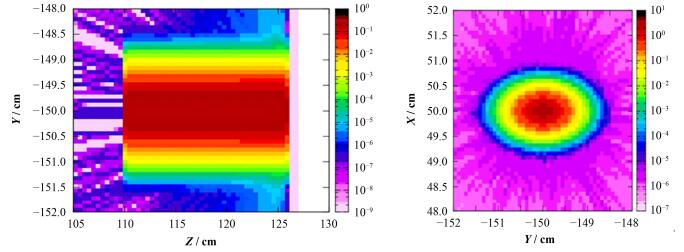
|
图 4 质子照射到靶室上的输运过程 Figure 4 Transport process of proton irradiation on the target chamber. |
分别统计了不同束流45 μA、50 μA、60 μA、70 μA下,18F产量随时间的变化趋势,见图 5。在轰击时间相同下,束流越大产量越高,但是在短时间轰击范围内,如图 5所示60 μA和70 μA的两条时间-产量曲线在20-40 min时间段有较多交叉部分。观察回旋加速器初始阶段的运行状态,发现束流、射频曲线不够稳定,主要由于回旋加速器的射频系统、磁场系统以及离子源系统等都还处于一种半稳定状态,束流需要经过一定的时间后才能达到稳定。
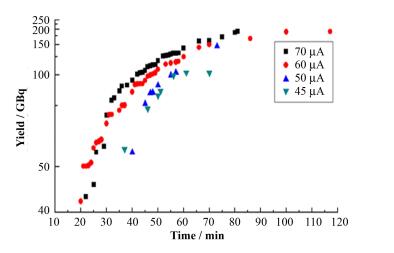
|
图 5 18F产量随轰击时间的关系 Figure 5 Relationship between 18F relative yield and irradiation time. |
在相同束流强度下,产量随着轰击时间而增加,但是增长趋势变缓,在轰击时间20-60 min情况下,产量与时间近似线性关系,60 min后增长趋势变缓,一段时间后产量将达到饱和状态。正电子核素18F相对产量(S)与时间(t)的关系可由式(1)来理论计算。
| $ S = {S_{\rm{M}}}\left( {1 - {{\rm{e}}^{ - \frac{{\ln 2}}{T}t}}} \right) $ | (1) |
式中:SM代表最大产量;T代表核素半衰期。
将核素18F的半衰期代入公式并对产量进行归一化计算绘制产量和时间的趋势图,如图 6所示。随着轰击时间的增长,初始阶段产量随时间增长快速增加,短时间轰击情况下,产量与轰击时间呈线性关系,此后产量随轰击时间的增长逐渐趋缓,最终达到饱和数值。
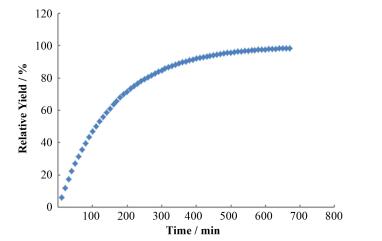
|
图 6 18F相对产量和轰击时间的关系 Figure 6 Relationship between 18F relative yield and irradiation time. |
根据实验数据和理论分析的结果,生产正电子核素18F的轰击时间以60 min左右为宜,束流越大核素产量越高,回旋加速器开机需要稳定后再开始照射。
2.3 质子能量使用蒙特卡罗FLUKA程序建立的质子辐照靶室模型,模拟计算正电子核素18F在单位束流单位时间下的相对产量与质子能量的关系,如图 7所示。在该质子辐照模型下,当质子能量为17-19 MeV时,可获得最高的正电子核素18F产量,质子能量过高或者过低核素产量都将降低,5 MeV能量以下的质子由于无法引发核反应将不会有正电子核素18F产出,当质子能量超过30 MeV时,18F核素产量约为峰值产量的10%。
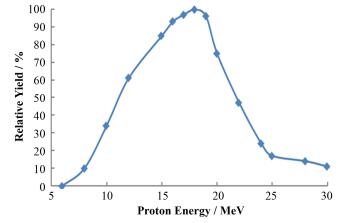
|
图 7 18F相对产量与质子能量的变化关系 Figure 7 Relationship between 18F relative yield and proton energy. |
本回旋加速器的束流引出口质子能量为20MeV,在束流轰击到靶室之前难免还会受到碳膜、靶膜、真空膜等物件的阻截,到达靶室的质子能量将降到17-19 MeV,这样将使得靶室系统获得合适的照射质子能量,从而获得较高的正电子核素18F产量。
2.4 Havar膜和靶水厚度合适的质子能量才能获得最佳的核素产量,使用蒙特卡罗SRIM程序模拟计算了20 MeV能量质子经过不同厚度Havar膜和不同厚度靶水后质子能量的变化,见表 1。20 MeV质子经过Havar膜和靶水将带来能量衰减,随着穿入深度的增加能量衰减加剧,当穿入一定距离后质子能量衰减为0,此距离即为质子的射程,20 MeV质子在水中的输运过程见图 8,其在靶水中的射程为3.8 mm。本研究质子辐照生产18F的系统,使用的真空膜和靶膜厚度合计为60 μm,靶水厚度3 mm,20 MeV初始能量的质子通过后能量将衰减为约6 MeV,质子能量主要沉积于靶水中,引发足够多的核反应18O(p, n)18F,故而可以得到较高的18F生产产额。
| 表 1 20 MeV质子穿过不同厚度Havar膜和水后的能量分布 Table 1 Energy distributions of 20-MeV protons passing through Havar films and water with different thicknesses. |
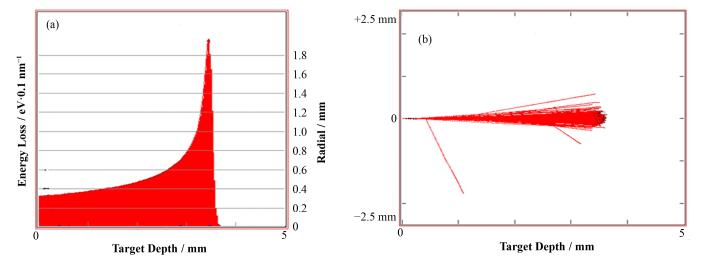
|
图 8 20 MeV质子在水中的能量沉积(a)和传输路径(b) Figure 8 Energy deposition (a) and transport paths (b) of 20-MeV protons in water. |
对于不同型号的回旋加速器,束流引出口的质子初始能量不尽相同,想要获得较高的核素生产产量,首先需要确定核反应所对应的最佳质子能量,而后通过模拟计算等方法来选择所需要的Havar膜和靶材料的厚度。对于20 MeV的质子回旋加速器,生产正电子核素18F使用的最佳Havar膜厚度为60μm,靶水厚度3 mm。
3 结语本研究对20 MeV质子回旋加速器生产正电子核素18F的生产条件和轰击参数进行了蒙特卡罗方法模拟和实验分析,根据分析结果给出了最佳生产条件和工艺,以期获得高效的生产产额。影响生产产量的因素总结如下:1)针对不同能量的质子照射,需要选择合适厚度的Havar膜并控制填充靶水的厚度,使得靶材料受到的等效质子能量接近于核反应激发函数曲线最高反应截面能量,可通过蒙特卡罗方法模拟计算来设计所需要的Havar膜和靶室尺寸(当质子能量为20 MeV时,Havar厚度60μm,靶水厚度3 mm);2)回旋加速器运行期间需要密切关注束流的稳定状况,调节磁场和射频参数使得束流充分照射到靶材料上,进而最大化的利用束流引发足够多的核反应提高产量;3)根据实际生产需要选择合适的束流强度和轰击时间,由于核素的衰变性质,18F核素的轰击时间以60 min为宜,开机等待磁场和射频稳定后再启动照射。
正电子核素的生产过程中还有许多需要考虑的影响因素,譬如产品会有其它放射性核素的杂质,需要经过纯化后才不会影响标记合成的效率;轰击过程中靶室的散热问题,冷却系统和真空系统的影响等;束流增大会带来辐射剂量率增大,如何加强辐射防护等问题[11-18]。回旋加速器及其附属设备需要定期进行维护和保养,才能保证机器正常稳定生产,从而最大化地提高生产效率。
| [1] |
Dave S R, Samuel T A, Pucar D, et al. FDG PET/CT in evaluation of unusual cutaneous manifestations of breast cancer[J]. Clinical Nuclear Medicine, 2015, 40(1): 63-67. DOI:10.1097/RLU.0000000000000553 |
| [2] |
Lu Y Y, Chen J H, Liang J A, et al. 18F-FDG PET or PET/CT for detecting extensive disease in small-cell lung cancer:a systematic review and meta-analysis[J]. Nuclear Medicine Communications, 2014, 35(7): 697-703. DOI:10.1097/MNM.0000000000000122 |
| [3] |
Teixeira S C, Peeters M J T V, Stokkel M P, et al. The role of PET/CT for nodal staging in primary stage Ⅱ/Ⅲ breast cancer patients[J]. Breast Cancer Management, 2015, 4(3): 165-174. DOI:10.2217/bmt.15.9 |
| [4] |
Agarwal K K, Sharma P, Singla S, et al. A rare case of non-small cell lung cancer metastasizing to the pituitary gland detection with 18F-FDG PET-CT[J]. Clinical Nuclear Medicine, 2014, 39(5): 318-319. DOI:10.1097/RLU.0b013e31828da679 |
| [5] |
王风, 林敏, 叶宏生, 等. 质子吸收剂量校准中蒙特卡罗方法的应用[J]. 原子能科学技术, 2011, 45(10): 1270-1274. WANG Feng, LIN Min, YE Hongsheng, et al. Application of Monte Carlo method in calibration technology of proton absorbed dose[J]. Atomic Energy Science and Technology, 2011, 45(10): 1270-1274. |
| [6] |
Remetti R, Burgio N T, Maciocco L, et al. Monte Carlo simulation and radiometric characterization of proton irradiated[18O]H2O for the treatment of the waste streams originated from[18F]FDG synthesis process[J]. Applied Radiation and Isotopes, 2011, 69(7): 1046-1051. DOI:10.1016/j.apradiso.2011.02.008 |
| [7] |
Sadeghi M, Jokar N, Kakavand T, et al. Prediction of 67Ga production using the Monte Carlo code MCNPX[J]. Applied Radiation and Isotopes:Including Data, Instrumentation and Methods for Use in Agriculture, Industry and Medicine, 2013, 77: 14-17. DOI:10.1016/j.apradiso.2013.02.001 |
| [8] |
Infantino A, Cicoria G, Pancaldi D, et al. Prediction of 89Zr production using the Monte Carlo code FLUKA[J]. Applied Radiation and Isotopes, 2011, 69(8): 1134-1137. DOI:10.1016/j.apradiso.2010.11.027 |
| [9] |
Bolch W E. The Monte Carlo method in nuclear medicine:current uses and future potential[J]. Journal of Nuclear Medicine, 2010, 51(3): 337-339. DOI:10.2967/jnumed.109.067835 |
| [10] |
Hess E, Takács S, Scholten B, et al. Excitation function of the 18O(p, n)18F nuclear reaction from threshold up to 30MeV[J]. Radiochimica Acta, 2001, 89(6): 357-362. DOI:10.1524/ract.2001.89.6.357 |
| [11] |
Link J M, Krohn K A, O'Hara M J. A simple thick target for production of 89Zr using an 11 MeV cyclotron[J]. Applied Radiation and Isotopes:Including Data, Instrumentation and Methods for Use in Agriculture, Industry and Medicine, 2017, 122: 211-214. DOI:10.1016/j.apradiso.2017.01.037 |
| [12] |
Tang Y, Li S, Yang Y, et al. A simple and convenient method for production of 89Zr with high purity[J]. Applied Radiation and Isotopes:Including Data, Instrumentation and Methods for Use in Agriculture, Industry and Medicine, 2016, 118: 326-330. DOI:10.1016/j.apradiso.2016.09.024 |
| [13] |
Pandey M K, Bansal A, Engelbrecht H P, et al. Improved production and processing of 89Zr using a solution target[J]. Nuclear Medicine & Biology, 2015, 43(1): 97-100. DOI:10.1016/j.nucmedbio.2015.09.007 |
| [14] |
Ellison P A, Valdovinos H F, Graves S A, et al. Spot-welding solid targets for high current cyclotron irradiation[J]. Applied Radiation and Isotopes, 2016, 118: 350-353. DOI:10.1016/j.apradiso.2016.10.010 |
| [15] |
Khandaker M U, Kim K, Kim G, et al. Cyclotron production of the 105, 106mAg, 100, 101Pd, 100, 101m, 105Rh radionuclides by natPd(p, x) nuclear processes[J]. Nuclear Instruments and Methods in Physics Research Section B:Beam Interactions with Materials and Atoms, 2010, 268(14): 2303-2311. DOI:10.1016/j.nimb.2010.04.002 |
| [16] |
Kirienko M, Sollini M, Lopci E, et al. Applications of PET imaging with radiolabelled choline (C-11/18F-choline)[J]. The Quarterly Journal of Nuclear Medicine & Molecular Imaging, 2015, 59(1): 83-94. |
| [17] |
王风, 杨建华, 谢卿, 等. 20 MeV医用回旋加速器对环境辐射的影响与分析[J]. 医疗卫生装备, 2016, 37(6): 101-104. WANG Feng, YANG Jianhua, XIE Qing, et al. Analysis of radiation effect to environment around a 20 MeV medical cyclotron[J]. Chinese Medical Equipment Journal, 2016, 37(6): 101-104. DOI:10.7687/J.ISSN1003-8868.2016.06.101 |
| [18] |
Steinbach J, Guenther K, Loesel E, et al. Temperature course in small volume[18O]water targets for[18F]F-production[J]. International Journal of Radiation Applications & Instrumentation Part A Applied Radiation & Isotopes, 1990, 41(8): 736-753. |


